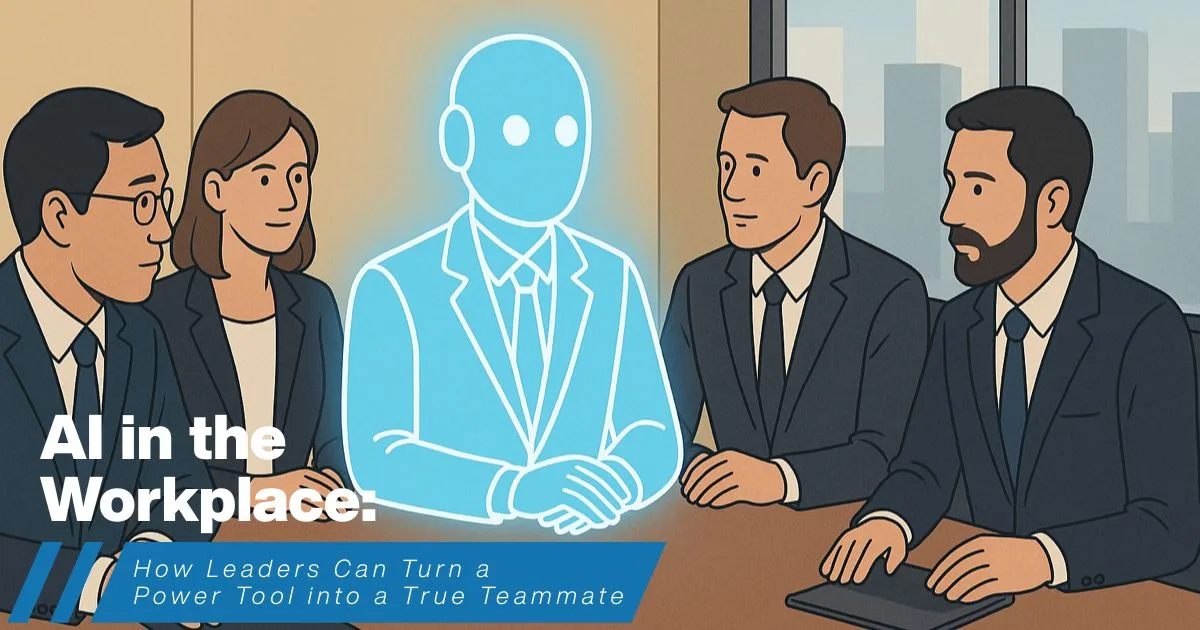For years, headlines warned that AI would replace entire industries overnight. Jobs lost. Roles made irrelevant. Human workers cast aside by algorithms. But what if the real challenge isn’t AI taking our jobs… but us learning how to work with it effectively?
The truth is, AI hasn’t ended work. It has changed the nature of it. And how we, as leaders and professionals, respond to that change will determine whether AI becomes a multiplier of human potential or just another distraction.
AI is one factor, but culture is the real driver of retention. Read more in our article on Culture: The Missing Link Between Recruitment and Retention.
The Real Fear: AI in the Workplace as Job Killer
Common Myths About AI in the Workplace
Fear sells. And the narrative that “AI is coming for your job” has been everywhere. Some reports predicted that 300 million jobs worldwide could be automated. Recruiters, creatives, even analysts, no function seemed safe.
But here’s the overlooked reality: jobs don’t disappear in a vacuum. They evolve. Technology always reshapes work. The printing press didn’t eliminate writers. Spreadsheets didn’t erase accountants. Instead, each shift raised the bar for human contribution.
The danger isn’t that AI will replace us. The danger is that we won’t adapt fast enough to use it well.
So how should we really think about AI?
Reframing AI in the Workplace: Junior Employee, Not Replacement
Why the Junior Employee Metaphor Resonates
Sam Altman, CEO of OpenAI, once described AI not as a replacement, but as an “all-knowing, all-powerful junior employee.” It’s a powerful metaphor worth unpacking.
Think about what a junior hire brings to your team:
- Massive potential, but no experience.
- Eager to work, but lacking context.
- Needs guidance, training, and clear direction.
Now imagine giving that same employee unlimited energy, instant recall of everything ever written, and the ability to process information at lightning speed. That’s AI.
Left unsupervised, your “junior employee” will produce work that’s fast, but not always accurate, ethical, or aligned with your goals. With the right guidance, though, it can become a force multiplier.
The High-Powered Tool in Unskilled Hands
Risks of Misusing AI in the Workplace
Here’s another way to look at it. AI is like being handed a high-powered instrument. In skilled hands, it can build something extraordinary. In unskilled hands, it risks damage, both to the tool itself and to the people depending on it.
If you were given a surgical robot tomorrow, would you trust yourself to operate on a patient? Probably not. The instrument isn’t the problem. The lack of skill, process, and discipline is.
The same applies to AI in professional settings. Leaders who simply “hand over tasks to AI” without process or oversight risk creating sloppy work, misinformation, or worse… eroding the trust of their teams and clients.
So the real question becomes: how do we bridge the gap between AI’s capability and our ability to harness it responsibly?
Leadership and AI in the Workplace: Why Humans Still Matter
Building Governance and Culture for AI in the Workplace
AI doesn’t replace judgment. It amplifies it. And leaders who understand this will be the ones who set the pace in the years ahead.
From my work with organizations on communication, sales, and leadership training, the same principle always applies: tools are only as effective as the clarity and confidence of the person using them.
That’s why human skill and guidance matter more than ever. Consider three areas where leadership must step in:
- Prompt Design – Just like asking the right discovery questions in sales uncovers true buyer needs , asking AI the right questions unlocks its potential. Poorly framed prompts lead to shallow results.
- Process Building – In sales, consistency of follow-through builds trust . With AI, having processes around how it’s used ensures accountability, quality, and alignment with outcomes.
- Governance & Culture – DISC teaches us that people process information differently . Likewise, teams will approach AI with different levels of trust, fear, or resistance. Leaders must set cultural norms for how AI is integrated, what’s acceptable, what’s off-limits, and how to keep humans in the loop.
Without this guidance, AI isn’t a strategic partner. It’s a liability.
External Insights: Why This Matters Now
Two recent insights underline this urgency.
- McKinsey (2024) noted that organizations embedding AI effectively are seeing productivity gains of 20–30%, but only when paired with strong leadership processes—not when left to “plug and play.”
- Harvard Business Review (2023) highlighted that the biggest AI failures weren’t technical—they were cultural. Leaders failed to build trust, alignment, and governance, leading to stalled adoption.
The message is clear: it’s not about the technology. It’s about how we, as leaders, integrate it.
Reflective Questions for Leaders
So let me ask you directly:
- If you were handed a high-powered tool but had never been trained to use it, would you trust yourself to build something lasting, or risk breaking it in your hands?
- Are you treating AI like an independent expert… or like a junior hire that still needs your leadership?
- What governance, training, and cultural norms have you established so your teams don’t just use AI, but use it well?
These are not just technical questions. They’re leadership questions.
The Path Forward: Human Skill + AI Scale
Practical Ways Leaders Can Scale AI in the Workplace
The future isn’t AI versus humans. It’s humans with AI.
AI brings speed, scale, and memory. We bring judgment, context, and wisdom. One without the other is incomplete. Together, they’re transformative.
The leaders who thrive in this new era will be those who:
- Treat AI as a partner, not a replacement.
- Build systems where AI enhances, not erodes trust.
- Invest in training teams to ask better questions, design better processes, and follow through with integrity.
Because just like in sales, communication, or leadership, it’s never about the tool alone. It’s about how you use it
Closing Thought
AI is not the end of human work, it’s the beginning of a new partnership. Like any junior employee or powerful instrument, its impact depends entirely on the clarity, guidance, and skill we bring to it.
The question is… are we ready to step up?
I’m Jonathan Engalla, and this is the space I’m actively exploring with leaders and organizations today. If this sparked something for you, let’s continue the conversation. Whether through workshops, consulting, or strategic dialogue, I’d love to help your team not just adopt AI, but adopt it with clarity, confidence, and culture.
For more on this idea, see Culture: The Missing Link Between Recruitment and Retention.






